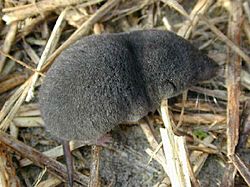Soricomorpha facts for kids
Quick facts for kids Soricomorpha |
|
|---|---|
 |
|
| Southern short-tailed shrew | |
| Scientific classification | |
| Kingdom: | |
| Phylum: | |
| Class: | |
| Infraclass: | |
| Superorder: | |
| Order: | |
| Suborder: |
Soricomorpha
|
The Soricomorpha ("shrew-form") was once a suggested group of mammals. It included animals like shrews, solenodons, and moles. Scientists first thought these animals belonged together. They divided this group into four families. One of these families is now extinct. The other three are the shrews, solenodons, and moles.
This idea came about when scientists studied the genes of these animals. They found that an older group, called Insectivora, wasn't a true natural group. This meant its members didn't all come from one common ancestor.
However, scientists later found a larger, true natural group. This new group includes all these insect-eating mammals. It is now known as the order Eulipotyphla. So, the Soricomorpha group is no longer used by scientists.
Contents
What Animals Were in Soricomorpha?
Even though Soricomorpha is not a current scientific group, it helps us understand how scientists classify animals. It included several interesting families.
Shrews: Family Soricidae
Shrews are small, mouse-like mammals. They have long snouts and tiny eyes. They are known for their very fast metabolism. This means they need to eat almost constantly to stay alive. Shrews are found all over the world. They live in many different habitats.
There are three main types of shrews:
- White-toothed shrews (Subfamily Crocidurinae): These shrews have white teeth.
- Red-toothed shrews (Subfamily Soricinae): These shrews have reddish teeth.
- African white-toothed shrews (Subfamily Myosoricinae): These are shrews found in Africa.
Moles: Family Talpidae
Moles are famous for living underground. They have strong front paws shaped like shovels. These paws help them dig tunnels very quickly. Moles usually have small eyes and ears that are hidden by their fur. They eat insects and worms found in the soil.
Some of the groups within the mole family include:
- Subfamily Scalopinae
- Subfamily Talpinae
- Subfamily Uropsilinae
Solenodons: Family Solenodontidae
Solenodons are rare, venomous mammals. They look a bit like large shrews. They are only found on the islands of Cuba and Hispaniola in the Caribbean. Solenodons are nocturnal, meaning they are active at night. They use their long snouts to find insects and other small animals to eat.
West Indian Shrews: Family Nesophontidae
This family of shrews is now extinct. They used to live on the islands of the West Indies. Scientists believe they died out after humans arrived on the islands. This happened because of new predators and changes to their habitat.
How Scientists Classify Animals
Scientists use a system to group living things. This system helps them understand how different species are related. They look at things like physical features and genetic information.
Understanding Clades
A clade is a group of organisms. It includes a common ancestor and all of its descendants. Think of it like a family tree. A true clade means all members share one ancestor.
Polyphyletic vs. Monophyletic
- Polyphyletic means a group of organisms does not share a single common ancestor. It's like grouping birds and bats together just because they both fly. They don't share a recent common flying ancestor.
- Monophyletic means a group includes a common ancestor and all of its descendants. This is a "natural" group. It shows a true evolutionary relationship.
The Soricomorpha group was found to be polyphyletic. This is why scientists stopped using it. They then found the Eulipotyphla group, which is monophyletic. This new group better shows the true relationships among these insect-eating mammals.
See also
 In Spanish: Soricomorpha para niños
In Spanish: Soricomorpha para niños

